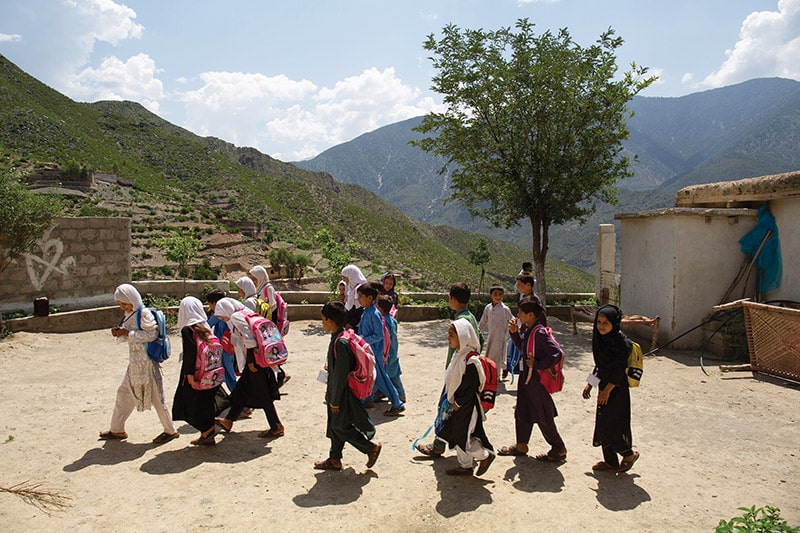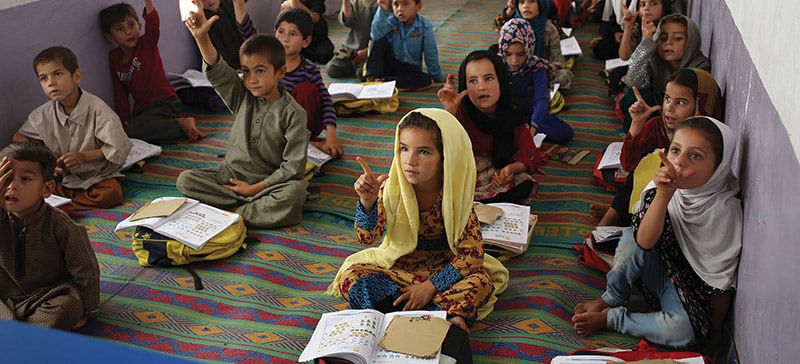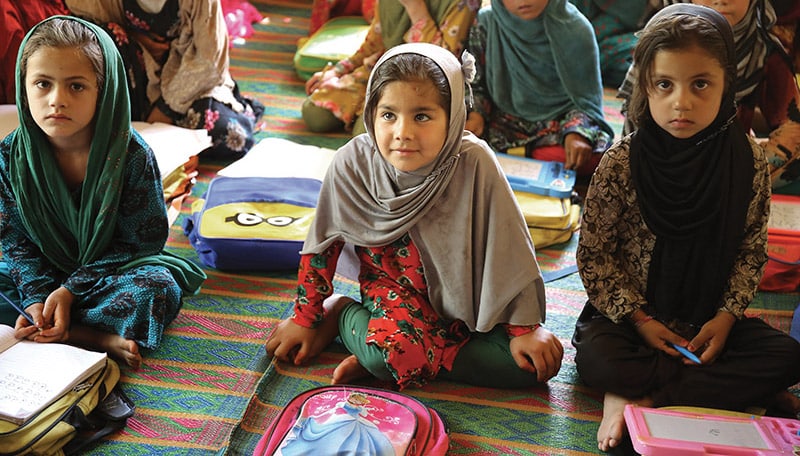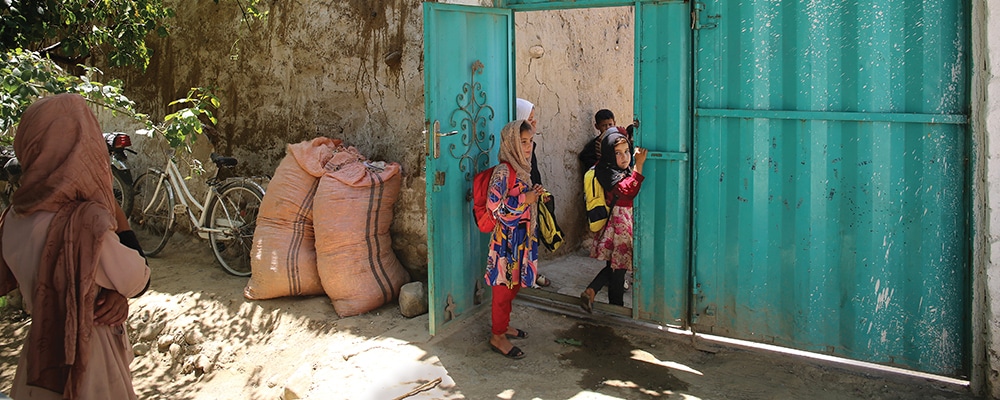Kids in rural Afghanistan get the chance to attend school for the first time
By Lynzy Billing
High up in the rugged mountains of Kunar province in northeastern Afghanistan, nestled between a small cluster of mud-brick homes, 6-year-old Jaweriya sat in a small classroom, carefully tracing over the letters of the Pashto alphabet with her tiny, hennaed hands.
Jaweriya wakes up at 5:00 a.m. to make the one-and-a-half-hour walk to this second-grade class in a community-based school in Spenkai village. Established in December 2020, it is the only school in the village. “We are learning the letters so if we go to the city, we can read the signs for the doctor,” said Jaweriya. “I want to learn them so I can teach my mother how to write her name.”
This community-based school is one of 49 schools established by Shining Star, one of CAI’s partner organizations in Afghanistan. Located in remote areas far from any public schools, these community-based schools provide classes for girls and boys in grades one to three who otherwise would not be attending school at all. With the support of CAI, Shining Star recruits and trains teachers and provides books, learning materials, school supplies, and furnishings. In 2022, CAI supported a total of 191 community-based schools across six provinces. In 2023, CAI hopes to expand its support to 250 communities to help meet the enormous needs.
Ten-year-old Hamidullah is another student at the community-based school in Spenkai village. “This school is very good because they gave us books and pens for our studies,” he said. “I never did any studies or had any books before because my father could not afford them. It’s the first school I have gone to, and I want to do very well in my classes because my father is not employed. But I will be a doctor.”

Older girls are given new opportunities
While the community-based schools are focused on grades one through three, the program also targets many older children who didn’t have access to schools when they were younger. For example, 12-year-old Osmania, a second-grade student at a community-based school in Spenkai village, began her schooling at age 11. That meant she was learning alongside 6-year-olds in first grade. “I talked with the elder of the village and my family and they allowed me to attend this school,” she explained.
After her school day, Osmania does her homework and then helps her mother with the chores, like washing the clothes, sweeping the floor, and looking after the animals. “Then I teach my mother what I have learnt at school,” she said. “Last night, I taught her the seasons of the year because she didn’t go to school.”
Teachers in these schools say that older students who have not received any schooling before can catch up through accelerated learning. This is particularly important for girls, who have always faced more roadblocks to getting an education and are now dealing with new restrictions under the Taliban regime. While boys at all levels have been permitted to attend school, the Taliban has blocked girls from attending secondary school (above grade six). Taliban officials have set no conditions or timeline for lifting the ban, insisting it’s only temporary. But the Taliban policy has met with resistance. In many parts of the country, tribal leaders, educators, and families are taking steps to ensure that older girls are provided with the education they need.
“I think for these older girls, accelerated learning is best, where in one year they can learn two grades,” said Kamel Farhat, deputy director of Shining Star. In 2022, CAI supported accelerated learning centers in which more than 1,200 older girls were enrolled.
Ultimately, the hope is that the Taliban will reverse the ban on girls’ secondary education. In the meantime, CAI is supporting additional programs to ensure these girls don’t fall behind in their studies, including at-home learning programs for high school girls and training courses for older female high school students who want to become teachers.

The whole community benefits when children go to school
One key aspect of the community-based school model is that the entire community is involved in the creation and management of the schools. First, the school must get the approval of the village elders or mullahs—the religious leaders of the community. They also decide where the school will be located, such as in a home or a mosque. Teachers are recruited from among the local populace based on their qualifications and are provided with training. Parents serve as volunteers.
Ibrahim, who is Jaweriya’s and Hamidullah’s teacher at the school in Spenkai village, has seen how the positive effects of the school ripple throughout the community. “The parents come to me and say these children are the future of this village,” he said. “Older children from the village ask me if I can provide classes for them, and sometimes old men from the village come and sit in the back of the class with notebooks because they want to learn.
They are eager because in the past there were no options for them to learn.” Ibrahim’s students must deal with many challenges. They’re often sleepy during class because they have to get up so early to walk to school. Some are hungry and unable to focus because their parents are too poor to provide them with a nutritious breakfast. Some struggle with homework because their parents and older siblings don’t have an education and can’t help them. But despite all this, his students and their families are grateful for their community schools.
“In many ways, my students are teachers at home to their families,” said Ibrahim. “Before, when the people of this village would travel to the city or district center, they were not able to read and understand the signs for the clinic. Now they can because their children have taught them.”

Overcoming conservative values and Taliban threats
With every new school that comes to a village, there are always obstacles that must be surmounted. One of the biggest is the conservative attitudes of the villagers and their long-held belief that girls should remain at home to do the housework and should never come in contact with boys when attending school. Some believe that educating girls is going against Islam.
According to Enayat-U-Rahman, a teacher at a girls community-based education (CBE) school, this couldn’t be further from the truth. “From an Islamic perspective, education is important for both boys and girls. But for girls, it is more important,” he said. “If a mother is educated, the child will learn from its mother, and she will encourage them to go to school also.”
Mohammad Gul, an imam and teacher at the CAI-supported school held inside a mosque in Kata Sang village, disagrees with the Taliban’s decision to ban girls from secondary education, saying there is no Islamic basis for it. “I told the villagers this. And they trust me because I am the imam in the mosque here,” he said. “When this school opened, many older girls came to me and asked to be enrolled in this class because there was no high school for them. The girls in this class are very sharp—even smarter than the boys.”
Mirza Mohammad, the imam at the mosque in Ashaba village in Parwan province, sees the Taliban’s decision as political and not in accordance with Islam. “Under Islam, girls have a right to education and work,” he explained. “It’s important for girls to get an education so that they and their children know their rights, including property rights and inheritance rights. More importantly, an education gives them a purpose in their lives to be someone. My daughter can choose what she wants to be in the future.”
Sometimes, the obstacles to providing an education to girls are life threatening. One man from Sondry village in Dara-I-Pech district of Kunar province described what happened when his community established a CBE school in December 2020, the first school in the village. “At the time, the Taliban was in the mountains around the government-controlled village, and they sent threatening letters to us saying that we must stop girls’ education here,” he recalled. “They said they did not want female teachers and doctors working in the village. They threatened to kill us, but we did not stop. Like my children were, I wanted all the children of this village to be educated, and that’s why we continued our work. And the community supported us also to stand against the Taliban.”
In fact, the school was such a success, even some of its most fervent critics changed their minds. “The funny thing is that now two of the Taliban that were threatening us want us to register their daughters in this class,” the man said. “They support the school now and they want secondary schools to be opened because they want girls from their own villages to be teachers and doctors.”

Giving up on education is not an option
In the foreseeable future, these villagers will continue to face major hurdles to providing an education to their sons and daughters. They will have to deal with too few schools to meet the growing demand, along with a shortage of teachers who are qualified to teach in them. They will confront the challenge of finding the funds needed to pay teacher salaries, maintain their classrooms, and provide books and other supplies to students. And they will have to face the fact that the ruling Taliban government will continue to try to prevent girls from getting the education they want so badly. But none of these challenges will stop them from trying—and succeeding. Just one year ago, there were few schools in the remote areas of Kunar, Kabul, and Parwan. Today, some districts have up to 25.
And the kids, with the support of their families, will keep on coming. Nine-year-old Farhat attends the CBE school in Shah Wali Khel village in Parwan province along with her 7-year-old sister Kosar. “Our mother told us to come to this class,” said Farhat. “Our father went to Iran to look for work six months ago. When he comes back, I’ll show him that I can read and write. And someday, I will be able to look for work so that he doesn’t have to.”







